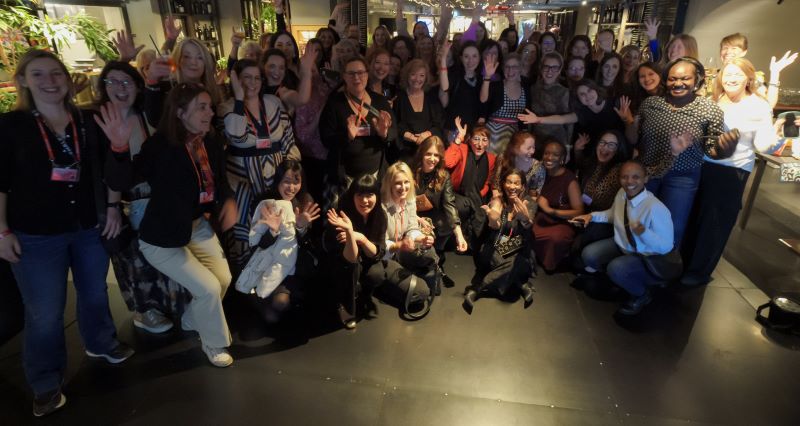



In case you missed it, 8 March was International Women’s Day. It was an opportunity for organisations to celebrate the achievements of the women in their workforce, notably on social media. The currency industry, traditionally viewed as a bastion of male dominance, was no exception.

It’s a women’s world! Some of the 250+ female participants at the recent Currency+Identity conference in Milan.
But how diverse are we really, and how far have we come in terms of gender parity?
Back in the day, and we are talking a good 20 years ago or more, as good a way as any to assess the gender diversity of the industry was to sit at the back of the conference room at industry gatherings and survey the backs of delegates’ heads. The picture used to be a near uniform one of short hair, or no hair. In other words, virtually all were men.
Nowadays, the picture is notable by the preponderance of long hair, bobs, ponytails, updos, hijabs. Even allowing for a more liberal approach to men’s hairstyles, this is a clear – if somewhat unscientific – demonstration that there are very many more women in our industry these days.
So far, so good.
But perhaps the hair survey as a metric doesn’t carry much weight, so let’s take a more factual approach to the matter, starting with the representation of women on our currency.
As the article on page from De La Rue shows, just one in 12 banknotes features a woman, or just over 7.5%. Another survey from Advisa in Sweden puts this at 15% (42 issuing authorities in total featuring a woman on one or more of their banknotes).
Either way, these low figures are not surprising. Generally speaking, portraits on banknotes are of historical figures – primarily military or political - and until relatively recently, women simply did not feature in public life. It was only from the 1980s onwards that female authors, poets, singers, painters and other artist were introduced, joined more recently by scientists and political activists.
Added to this, the figures are skewed by the portrait of the late Queen Elizabeth II on nearly half of those banknotes that feature women. Following her death, those portraits will either be replaced by that of her successor (a man), or other more locally representative imagery.
The picture is similar for coins – albeit that these are less likely to feature people than banknotes. Where they do, the effigy is generally of the reigning monarch or previous heads of state. Where coins do ‘better’ is in commemorative and collectors versions – the current American Women Quarters™ program, which over the course of four years is celebrating the achievements and contributions to US society of 20 different women, being a great example.
If we now turn to people in high places, a good place to start is central banks. How many have women at the helm? The answer is not many. As of the start of this year, women were governors of 29 of the world’s central banks and issuing authorities. Considerably better than the 16 at the start of 2022, but that was down from the 21 in 2014. So in 10 years, the needle has moved, but not by much.
In terms of the leaders of the major suppliers, none at the CEOs of publicly listed companies in our sector are women, and very few of either the non-listed suppliers or state printers are run by women – Canadian Bank Note Company, the US Bureau of Engraving and Printing and Perum Peruri being three notable exceptions.
For the minting community, which is arguably even more traditional than the banknote community, it is noticeable that women hold the top jobs in five of the largest mints - those of Canada, the UK, South Africa, Poland and the US (although the latter has just stepped down).
Even so, by the above metrics, the industry as a whole isn’t doing a great job in terms of parity.
But, as the saying goes, ‘that was then and this is now’, and there is very good cause for optimism. Because coming through the ranks at central banks, printers, cash management companies and suppliers alike are more and more women.
Taking central banks again, whilst most have men at the helm, a growing number of deputy governors and other senior managers are women. This is particular noticeable in the cash and/or issue departments, many of which are now female-led – among them the ECB and the central banks of the UK, US, Canada, Spain, Portugal, Italy, Chile, Israel, Sweden, Norway, Namibia, Uganda, South Africa, Mexico, Brazil, Jamaica, Hungary, Poland, Australia, the Philippines, Fiji…. The list goes on.
In the supplier community, meanwhile, although the leading companies may be run by men, the currency divisions of industry leaders such as De La Rue and Crane are headed by women.
And to give an indication of the direction of travel, at the recent Intergraf Currency+Identity conference, over 25% of the delegates were women. Still some way off parity, but a huge improvement versus a couple of decades back, when that first back-of-the-head survey took place. And it is this next generation of women who are the future leaders of our industry.
So the currency world is definitely on the right path to more parity and equality, even if it’s not there yet.